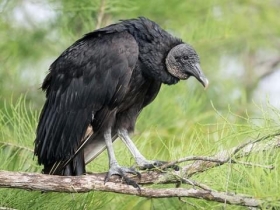
Black Vulture
Coragyps atratus
Animal Behavior: The Black Vulture has quick labored flight consisting of several wing flaps followed by a period of short glide. This vulture hunts by sight not smell, and usually soars higher and later in the day. When hunting, the vulture rides thermals upwards for terrestrial soaring while only flapping wings from time to time. The Black Vulture forages later in the day and is more aggressive when it reaches the animal carcass. Therefore, it effectively drives out other scavengers especially the Turkey Vulture. Usually the vultures are silent but may hiss, grunt, and utter low barking sounds when fighting over food. Black Vulture males court a female in a small group that walks around her with wings spread partly and rapid head bobbing. They are highly social, forming flocks to forage and roosting in large aggregations. These vultures form family units by associating with immediate kin and extended relatives. When startled, the vulture will regurgitate food that it has just eaten in order to be able to take off to fly.
Range: The Black Vulture prefers an open habitat and avoids dense forests as much as possible. Such habitats include lowlands with adjacent highlands, open fields, desert terrain, garbage dumps, and urban or rural centers.
Conservation Efforts: The Black Vulture is very common but in 1972 it was blue listed for two reasons: a decrease in numbers of suitable tree cavities for nest sites due to forest fire control, and widespread eggshell thinning from pesticides such as DDT. Its populations have rebounded, and it now considered a pest species due to population explosion in urban centers.
Animal Facts: The Black Vulture is black, large bird with a wingspan of 137-152 cm, a length of 50-69. The sexes are alike and the adults and the young have black, wrinkled bare skin on the head and neck. Black Vultures have weak feet, adapted more for running than for clutching, and relatively weak bills. The black vulture's feet stretch past its short tail. In flight, a short, square tail and a large white patch on the undersurface of the wing distinguishes them from turkey vultures. Turkey vultures are another large new world vulture which often occurs in the same area. These birds have been observed to live as long as 21 years in captivity and the oldest wild captured banded bird was 16 years old.
